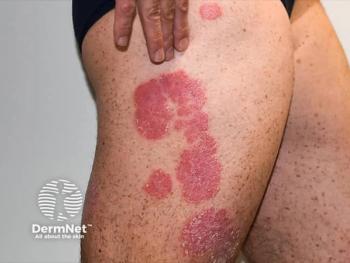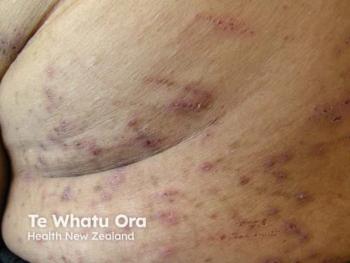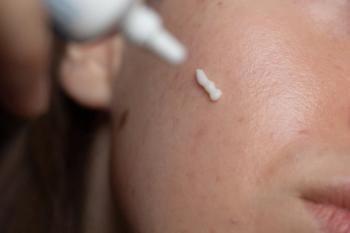
- Dermatology Times, June 2025 (Vol. 46. No. 06)
- Volume 46
- Issue 06
Optimizing Atopic Dermatitis Care With Emerging Topical Therapeutics
Key Takeaways
- Topical ruxolitinib offers rapid and effective relief for moderate AD, providing a steroid-free option amid increasing steroid phobia.
- In severe, refractory AD cases, clinicians should consider secondary drivers like Malassezia hypersensitivity, highlighting the value of peer collaboration.
At a recent Dermatology Times Case-Based Roundtable event, Lisa Swanson, MD, discussed 3 diverse atopic dermatitis patient cases.
“Steroid phobia is at an all-time high, but if it had to happen at any time in history, I'm so glad it's now because we're prepared. We have other options that we can use to help manage our patients with atopic dermatitis,” said Lisa Swanson, MD, FAAD, while highlighting her recent Dermatology Times Case-Based Roundtable custom event titled, Navigating Atopic Dermatitis Treatment: Case-Based Discussions on Optimizing Management.
Swanson, a double board-certified dermatologist and pediatric dermatologist at Ada West Dermatology in Boise, Idaho, discussed 3 diverse atopic dermatitis (AD) patient cases with invited attendees of the roundtable, offering real-world insights into the advancing topical and systemic treatment landscape.
Case No. 1: Moderate AD
A 13-year-old female patient with moderate atopic dermatitis (AD) had failed multiple topical corticosteroid therapies. Swanson noted that at her age, a wide range of topical and systemic options are available. Swanson highlighted the role of newly approved non-steroidal topicals—roflumilast 0.15% (Zoryve; Arcutis Biotherapeutics), tapinarof 1% (Vtama; Organon), and ruxolitinib 1.5% (Opzelura; Incyte), as well as systemic options if necessary. The roundtable discussion mainly focused on topical ruxolitinib, emphasizing its rapid onset of itch relief (notably 15-minute itch improvement data) and head-to-head superiority vs triamcinolone, a commonly prescribed corticosteroid.
Swanson’s Key Takeaway:
Topical ruxolitinib demonstrates powerful and rapid efficacy for moderate AD, making it an excellent steroid-free option at a time when steroid phobia among patients and families is at an all-time high. Clinicians should feel empowered by the extent of non-steroidal therapies now available.
Case No. 2: Severe, Refractory AD
Swanon’s second case involved a 28-year-old man with a lifelong history of severe AD, with prior treatment failures including topical steroids, topical calcineurin inhibitors (TCIs), crisaborole, dupilumab (Dupixent; Sanofi and Regeneron), and oral JAK inhibitors including upadacitinib (Rinvoq; AbbVie), abrocitinib (Cibinqo; Pfizer), and tralokinumab (Adbry; LEO Pharma). Despite extensive workup (including biopsies to rule out cutaneous T-cell lymphoma and patch testing to exclude contact dermatitis), therapeutic success was still not achieved. Topical ruxolitinib provided some symptomatic improvement, though it was used off-label due to the patient’s more than 20% body surface involvement. A breakthrough occurred when colleague Matthew Zirwas, MD, recommended antifungal therapy, leading to dramatic improvement with itraconazole, suggesting an overlooked Malassezia-driven component.
Swanson’s Key Takeaway:
When encountering recalcitrant AD, clinicians should consider secondary drivers such as Malassezia hypersensitivity. Collaboration with peers can uncover overlooked diagnoses and reinforce the importance of open case discussions among colleagues.
Case No. 3: Tactile Sensitivities and Moderate AD
An 8-year-old boy with moderate AD and significant tactile sensitivities presented challenges in topical adherence. Though topical corticosteroids, TCIs, roflumilast, and tapinarof were options, Swanson discussed with attendees the anticipated expanded approval for topical ruxolitinib down to age 2, based on promising pediatric data (
Swanson’s Key Takeaway:
In patients with tactile sensitivities, selecting well-tolerated topical agents is crucial, however, clinicians should remain flexible and consider systemic therapies when topical regimens are not feasible.
Roundtable Highlights
Swanson led a dynamic and insightful roundtable discussion with attendees focused on the evolving topical treatment landscape for AD. The discussion began with reflections on the long-standing role of topical corticosteroids, highlighting their affordability and short-term effectiveness, while emphasizing their limitations in long-term disease management. Swanson and attendees noted the growing phenomenon of steroid phobia among patients and families, making the availability of effective non-steroidal options more critical than ever.
Swanson and the attendees covered newly available agents, including tapinarof, which demonstrated impressive efficacy in moderate to severe AD down to age 2. The roundtable attendees were particularly excited by its potential remittive effect, allowing many patients to remain off therapy for extended periods. Topical roflumilast 0.15% was another highlight, offering once-daily treatment down to age 6, with data showing that 57% of patients maintained disease control on twice-weekly use for a year (
Topical ruxolitinib also featured prominently in the conversation. Swanson praised its rapid efficacy, excellent tolerability, and positive patient feedback. While acknowledging limitations such as the 20% BSA restriction, combination use caution with dupilumab, and the boxed warning, she emphasized its overall transformative impact in clinical practice.
Overall, the roundtable captured the excitement around new therapies and underscored how these advancements are reshaping atopic dermatitis management across pediatric and adult populations.
Articles in this issue
6 months ago
Dermatology Times June 2025 Print Recap6 months ago
Nail Trends That Challenge Clinical Diagnosis6 months ago
Inside IL-17 Inhibitors Advancing Psoriasis CareNewsletter
Like what you’re reading? Subscribe to Dermatology Times for weekly updates on therapies, innovations, and real-world practice tips.


















